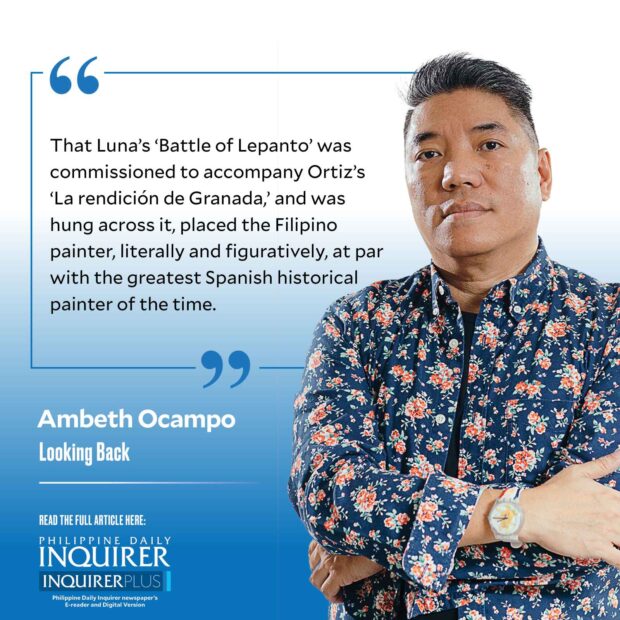Injustice to Juan Luna

It took Sen. Pia Cayetano, on an official visit to the Palacio del Senado in Madrid, Spain, to bring public attention to “The Battle of Lepanto,” one of Juan Luna’s major but inaccessible paintings. In a recent Instagram post, she posed in front of Luna’s masterpiece where it has been languishing in a narrow badly-lit corridor off the formal session hall. It is not well-known that when Luna was awarded one of three first class or gold medals for “Spoliarium” at the 1884 National Exposition of Fine Arts in Madrid; he won one of the top prizes, but not the coveted prize of honor that was not awarded that year.
From accounts in the press at the time, “Spoliarium” was the crowd favorite so when Spanish King, Alfonso XII, received the prize-winning artists of the 1884 Exposition of Fine Arts, he is said to have expressed to Luna both his congratulations and his personal disappointment that the Filipino was denied the Premio de Honor. Alfonso’s encouragement hinted that things would be made right.
In 1884, the Marques de la Habana, president of the Spanish senate, commissioned Francisco Pradilla Ortiz, awarded the 1878 Medal of Honor, to do the first of four large scale historical paintings to decorate the Salon de Conferencias, a holding room adjoining the Senate session hall. The remaining three commissions were awarded to the three winners of the 1884 National Exposition of Fine Arts: José Moreno Carbonero, Antonio Muñoz Degrain, and Luna.
Article continues after this advertisementLuna presented a study in 1885, and was paid 30,000 pesetas, for the work finished in Paris, and transported to Madrid where it was unveiled by the Queen Regent and the Infanta Isabel on Nov. 29, 1887, before they proceeded from the Salon de Conferencias to the formal opening of an extraordinary session of the Senate. That Luna’s “Battle of Lepanto” was commissioned to accompany Ortiz’s “La rendición de Granada,” and was hung across it, placed the Filipino painter, literally and figuratively, at par with the greatest Spanish historical painter of the time. This implied honor was not lost on Federico de Madrazo, who used his considerable influence as: court painter, director of the Museo del Prado, director of the Real Academia de Bellas Artes de San Fernando, juror of the Exposicion Nacional de Bellas Artes, and senator, to thwart Luna’s success.
On April 13, 1885, Madrazo described Luna’s “boceto” or study for “Lepanto” as follows:
“The other day I was in the Senate and I saw the sketch that Luna has sent of the Battle of Lepanto that was commissioned from him. It is too busy and ungrateful at the same time for many reasons, and I do not know why he has sent a sketch, that the same can be looked upside or upside down. It is nothing, and a good painting could be made from it as well as a bad one. So much charlatanism there is in this world! Fact is that just as most who have seen it say they do not understand what it is, others say that it is magnificent … it seemed to me that it is nothing and that everything else can represent a dirty palette.”
Article continues after this advertisementNot alone in his disdain for Luna, Madrazo found an ally in countess Emilia Pardo Bazán who in her book “At the foot of the Eiffel Tower” (Madrid, 1889) thrashed Spoliarium as a “colossal study [boceto] … a brave badly finished composition [that betrayed] genius born with the vigor and strength of the harriers [aguiluchos].” She could not resist a racial slur describing Luna “although Spanish by birth is of a yellow race.” Of “Lepanto,” Pardo Bazán reported it as “the object of very bitter criticism; the color has seemed sour and the figures scream … misunderstood.”
Early in 1889, Luna requested that “La batalla de Lepanto” be loaned by the Senate for the Spanish pavilion in the Universal Exposition in Paris. He even offered to defray all shipping and other costs relative to the loan. Luna’s request was denied. Filipino expats like Rizal and Marcelo del Pilar sensed that some envious Spanish artists were working against Luna. While there is no smoking gun on his involvement in this decision, it is to be noted that the biased Madrazo was on the organizing committee for the Spanish exhibits at the Paris Universal Exposition. Furthermore, it is probable that Madrazo had a hand in the last and most cruel indignity to Luna’s “Battle of Lepanto.”
In 1895, “Lepanto” was removed from the Salon de Conferencias and replaced by another painting. “Lepanto” was consigned to a nearby corridor but briefly returned to its original space sometime in 1937, during the time of Generalissimo Francisco Franco when the Palacio del Senado was used by the Consejo Nacional del Movimiento and the original arrangement of the paintings in the Sala de Conferencias was restored. “Lepanto” was moved again sometime after 1974, consigned to the insignificant pasillo where I viewed it in December 2019. We should lobby that Luna’s rightful place in the Palacio del Senado be restored.
—————-
Comments are welcome at aocampo@ateneo.edu
















